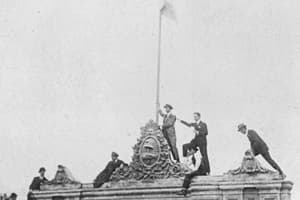Podcast
Questions and Answers
¿Cuál evento marcó el comienzo de la lucha por la independencia de Argentina?
¿Cuál evento marcó el comienzo de la lucha por la independencia de Argentina?
- La Revolución de Mayo (correct)
- Las presidencias notables
- La era de Rosas
- La Constitución de 1853
¿Qué documento estableció un sistema federal de gobierno en Argentina?
¿Qué documento estableció un sistema federal de gobierno en Argentina?
- La era de Rosas
- La Revolución de Mayo
- Las presidencias notables
- La Constitución de 1853 (correct)
¿Quién lideró la Revolución de Mayo en 1810?
¿Quién lideró la Revolución de Mayo en 1810?
- Carlos María de Alvear
- Cornelio Saavedra (correct)
- Domingo Faustino Sarmiento
- Juan Manuel de Rosas
¿Qué documento sentó las bases para un sistema político más estable en Argentina?
¿Qué documento sentó las bases para un sistema político más estable en Argentina?
¿Quiénes fueron algunos de los líderes revolucionarios durante la Revolución de Mayo?
¿Quiénes fueron algunos de los líderes revolucionarios durante la Revolución de Mayo?
¿Cuál líder argentino fue responsable de establecer una dictadura que duró casi dos décadas y provocó conflictos internos intensos?
¿Cuál líder argentino fue responsable de establecer una dictadura que duró casi dos décadas y provocó conflictos internos intensos?
¿Qué evento marcó el inicio de la independencia de Argentina en el siglo XIX?
¿Qué evento marcó el inicio de la independencia de Argentina en el siglo XIX?
¿Quiénes fueron algunos de los presidentes destacados del período de presidencias entre 1853 y 1880?
¿Quiénes fueron algunos de los presidentes destacados del período de presidencias entre 1853 y 1880?
¿Qué estableció la Constitución de 1853 en Argentina?
¿Qué estableció la Constitución de 1853 en Argentina?
¿Qué contribuyó a que Argentina se convirtiera en un importante exportador durante la era de Rosas?
¿Qué contribuyó a que Argentina se convirtiera en un importante exportador durante la era de Rosas?
¿Qué caracterizó la era posterior a la caída del régimen de Rosas en Argentina?
¿Qué caracterizó la era posterior a la caída del régimen de Rosas en Argentina?
Study Notes
Argentina's Transformative Decades: 1810-1860
During the first half of the 19th century, Argentina experienced a tumultuous period of profound change marked by the May Revolution, the drafting of a new constitution, the rise of a powerful caudillo, and several notable presidencies. This era set the foundation for a young nation that would eventually emerge as one of Latin America's most prominent economies and democracies.
May Revolution (1810)
In the wake of the Napoleonic Wars, Buenos Aires, then part of the Spanish Empire, declared independence from Spain on May 25, 1810, ushering in the May Revolution. The revolutionaries, led by the likes of Cornelio Saavedra, Carlos María de Alvear, and Mariano Moreno, sought to establish a sovereign Argentine nation. This event is often considered the birth of Argentine nationalism and the beginning of a protracted struggle against Spanish rule.
The Constitution of 1853
While the May Revolution set Argentina on a path to independence, the country's political structure remained volatile and decentralized for much of the following decades. In 1853, a new Constitution was adopted, which established a federal system of government with a president and two legislative chambers. This document, influenced by the United States' own Constitution, laid the foundation for a more stable and cohesive political system in Argentina.
Rosas Era (1832-1852)
The Rosas era, led by General Juan Manuel de Rosas, was a significant period in Argentine history characterized by authoritarian rule and intense internal conflict. Rosas consolidated his power through violent means, establishing a dictatorship that lasted nearly two decades and drew the ire of neighboring countries as well as the Argentine opposition. During his reign, Rosas implemented policies that favored the production of wool, which helped Argentina become a major exporter, but also contributed to the country's social and economic inequalities.
Presidencias 1853-1880
Following the fall of Rosas' regime, Argentina entered a more democratic era characterized by a series of presidential administrations that sought to establish a stable and prosperous nation. Notable presidents from this period include Justo José de Urquiza, Bartolomé Mitre, Domingo Faustino Sarmiento, and Santiago Derqui. These leaders, though often facing significant challenges, laid the groundwork for a more democratic and stable Argentina.
The first half of the 19th century in Argentina was marked by significant political and economic transformations. The May Revolution set the stage for the country's independence, while the Constitution of 1853 established a more stable federal government. The Rosas era, while emblematic of authoritarian rule, also helped Argentina become a major exporter and set the stage for future economic development. The presidencies that followed the fall of Rosas set the foundation for Argentina's emergence as a democratic and prosperous nation. Though the era was not without challenges, it ultimately laid the groundwork for a more stable and prosperous Argentina.
Studying That Suits You
Use AI to generate personalized quizzes and flashcards to suit your learning preferences.
Description
Test your knowledge on the May Revolution, Constitution of 1853, Rosas era, and presidencies in Argentina from 1810 to 1860. Learn about the political and economic transformations that shaped the foundation of a young Argentine nation.




